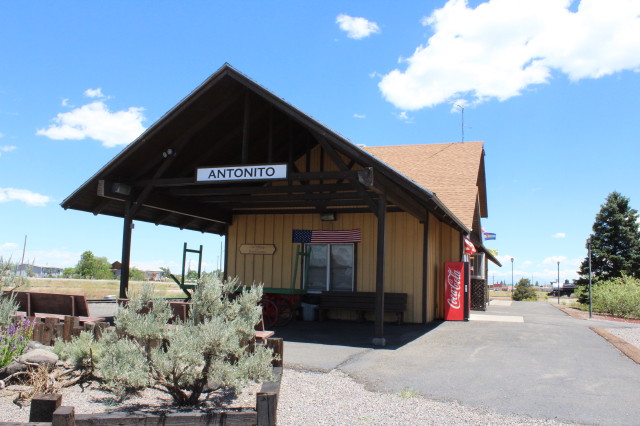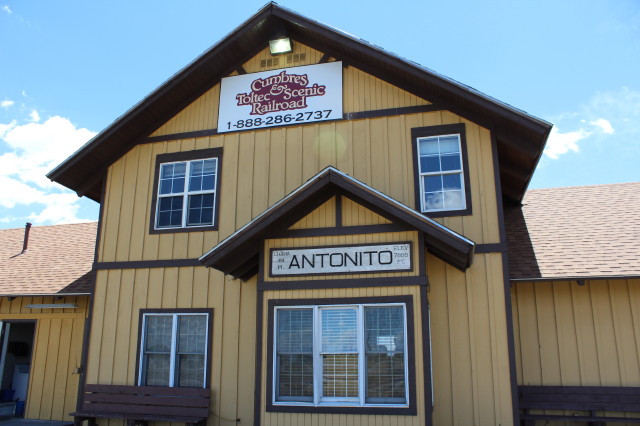


From here we made several more stops going north on Rt 17.











Cresco, Colorado, elev 9,193.
Just inside the
Colorado boundary line, the present water tank was built
in 1893. Several families lived here year round, and
their only continuous contact with the "outside World"
was with the daily trains. The train makes eleven
boundary crossings on the way to Antonito, CO.




Standing in New Mexico looking toward Colorado.

Wolf Creek Valley.


Approaching crossing at Rt 17.

The eastbound train labors up the steep four percent grade and
wind around Windy Point on its way to Cumbres Pass.
From here we stayed on Rt
17 to Cumbres Pass to catch the train arriving here and
taking on water.



Cumbres Pass, the
highest point along the C&TS and the end of the 4%
grade. The engine will take on water for the rest of the
trip to Antonito. The depot was built in 1882 but was used
as a section foreman's house. The original depot was torn
down by the Rio Grande in 1954. When the Narrow Gauge was
built, the elevation was determined to be (without the use
of GPS) to be 10,015 feet above sea level. However, the
Colorado Department of Transportation has Cumbres Pass as
10,022 feet.



Between Chama and Cumbres, the engine will use 2 1/2 to 3 1/2
tons of coal and about 3,500 gallons of water. For the
remaining 51 miles between Cumbres and Antonito, the engine
will use an additional two to three tons of coal.



Cumbres means "crests" or "summits" in Spanish. Highest point
on the railroad!








Final shot of our chase of the eastbound Cumbres & Toltec
Scenic Railroad.
From here Chris and I followed Rt 17 to Antonito.

Colorado is going green.

Antonito, Co.
Long before the railroad, an old Spanish Trail passed through
the site of the present train yard.

495 2-8-2 built 1928 on display.


Coaches 504 -Sublette and 506 - San Luis.

#19 Class: DE B+B 22(diesel-electric), built 1943, General
Electric.
Known as the "Pineapple." It was originally purchased by
Scenic Railways in 1972 from the Oahu Railway in Hawaii and
later bought by the C&TS.


05635 - built from stock car 5635, 1976.



OP built 1911 construction derrick.



Outfit Cook Car 053. Purchased from D&RGW, 1970 3D-foot
RPO converted for use as a cook car. Assigned to rotary OY
snowplow.

3244 restrooms/ concession.

494 2-8-2 built 1928 on display.




This station is the
eastern terminus of the C&TS. None of the
buildings and railroad facilities surrounding the
present C&TS depot were here until after the states
purchased the line from the Denver & Rio Grande Western
Railroad (D&RGW) in 1970. They were largely built with
volunteer labor and a number of financial grants.With a
great deal of hard work and community effort, local
residents built the small depot, a wye, storage tracks and
facilities for servicing engines by the summer of 1971 when
the C&TS officially opened for business. The small depot
is now an office for the C&TS Railroad Commission.


Chama 64 M Elev 7888 Ft.

Highway display front of depot.
Leaving the depot by Rt 17 to the US 285 junction, we then
went north on US 285 to our next stop.


Elev 7597 Denver 266 M.
Continuing north on US 285, our next stop was at Alamosa.

Adjacent the station was a storage yard with some very
interesting cars.

This end of the dorm car is attached to the baggage car and
the other end to the Superliners.




Also in Alamosa at their Cole Park.

# 169 - 4-6-0 built 1888.





San Luis Central Railroad.
Continuing on US 285 to our next stop.

Monte Vista Rio Grande Station.

From Monte Vista, we changed to US 160 for our next stop.

Del Norte Rio Grande Station.

Leaving Del Norte we traveled west on US 160 to our next stop.
South Fork Rio Grande Station

Elev 8188 Ft - Denver 299.9 Mi
The town of South Fork is named for its proximity to the south
fork of the Rio Grande. Since its beginnings as a stagecoach
stop in the 1880s, timber processing, agriculture, mining and
ranching as well as tourism and recreation have contributed to
the town's economy.


At the time of our visit there were no trains operating or
running due to trackage rights problems. We were told to look
around and explore.













A popular spot to meet the Rio Grande River.


Leaving South Fork we headed east on US 160 passing this
display of old railroad cars. Who, What and Why here?







Across the highway from the cars was this water tower. We
drove over for a closer look.


From here we continued on east on US 160 to CO 112 then east
on that to US 285. North on US 285 to our old friend US 50. We
went east on US 50 to Sailda and our stop for the night.
Salida, CO

Koppers Co. Railways 0-4-0T built 1926 Narrow (24")


Next stop was to find American Classic Inn, our room for the
night. After getting checked in, Chris and I went to a steak
house, recommend by the motel manger. He said Quincy's was
just up the highway and lots of locals go there. We were happy
with his recommendation as we both had a great steak dinner.
After our nice meal we returned to the motel to get ready for
tomorrow and turn in for the night.

Well, It is Colorado.